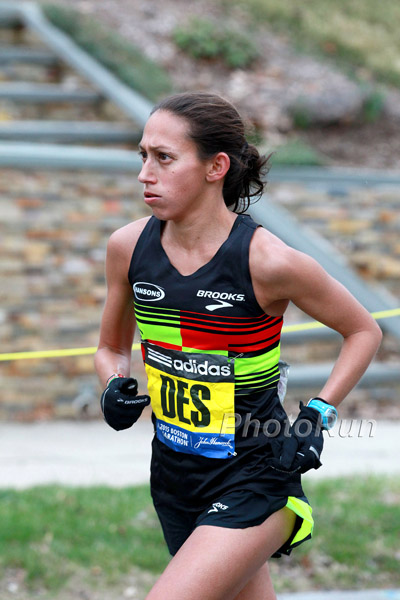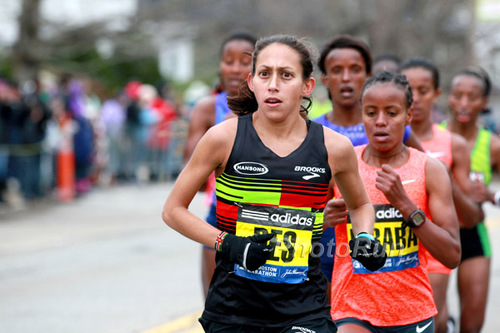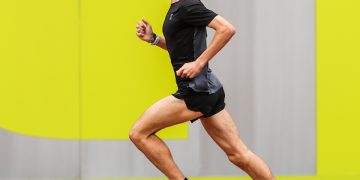For Desiree Linden, there were no regrets about today’s Boston Marathon. Though the eventual result-finishing 4th in 2:25:39-saw her fall just shy of reaching the podium, the way she approached the race-bold, brave, always attacking-at least left her content that she left every last ounce of energy out on the course.
As the field cruised through the opening miles at a sedate pace, Linden settled at the back of the leading pack and then moved swiftly to the front seven miles into the race. The 31-year-old then towed the field along into a stiff headwind for the following miles, but her efforts did little to chisel the pack down. “I knew it was going to be a war of attrition,” said Linden afterwards.
After passing halfway in 1:12:33, Linden was still surrounded by a group of athletes, but she hit the front again through 15 miles, trying in vain to reduce the leading back by keeping the pace at an honest effort.
“If we felt someone was going to take it, I’d have been happy to sit in,” said Linden. “When people came up on my shoulder and I felt it was going to pick up, I’d sit in, but then it would always slow down so I went back to the front.”
The front-running plan was hatched after consulting with coaches Kevin and Keith Hanson in the days beforehand, the trio aware that they needed to not allow the race turn into a sprint. “We knew she was going to have to be the aggressor,” said Kevin. “People will say it was suicidal to lead, but I think it would be suicidal to make it slow. If it was a jog-fest she may not have been top 10. She maximized herself and the plan wasn’t suicidal.”
Linden had come into this race with a near-perfect preparation, having logged 1,800 miles over the course of a 14-week marathon block, according to Kevin Hanson. They knew her strength was her strength, and they were keen to make it show.
After 17 miles, the first signs that Linden’s pace was beginning to hurt the pack showed when her former college teammate Amy Cragg, and next Shalane Flanagan, began to drop off the leading group.
Des Linden makes them hurt, photo by PhotoRun.net
Linden, though, still had eight other athletes for company, all East Africans, and all sheltering in her slipstream as they entered crunch time – the final run into the city and the eventual finish on Boylston street.
At that stage, Linden repeatedly stole glances behind her, trying to see if her pace was having the desired effect. Every time, though, she was greeted by the same sight, a horde of Kenyans and Ethiopians, including eventual race winner Caroline Rotich, waiting patiently for their time to pounce.
“I kept taking peeks back, but I knew I couldn’t slow and I just had to trust that it would work, but there were some great athletes in that field today.”
Linden would occasionally ease off the pace, slink to the back of the leading pack briefly, survey her competitors, then gather herself and surge once more, but the result, frustratingly, was always the same – it had little effect.
Just past 22 miles, Ethiopia’s Mare Dibaba made the first decisive surge, moving ahead and testing the leading pack, but soon eased off and again settled. With three miles to run, Mare Dibaba, Rotich and Buzunesh Deba finally broke clear, leaving Linden running alone in fourth, churning out the pace as best she could, hoping against hope that one of the leading trio would falter.
They didn’t, with Rotich going on to edge a sprint finish from fellow Ethiopian Dibaba, 2:24:55 to 2:24:59, and Deba taking third in 2:25:09. Thirty seconds behind, Linden came home in splendid, albeit still slightly dissatisfied, isolation, finishing in 2:25:39.
It was a much better performance than her run here last year, when she finished 10th, but still some way short of her second-placed performance from 2011.That race, though, happened before Linden sustained severe injury in 2012 and missed almost 12 months of training. Since then, she’s been slowly returning to top form, something that is shown by her gradual improvement in each major marathon since her comeback.
“They’re all stepping stones,” said Hanson. “We’re trying to look at the bigger picture. Since 2012, post-injury, every single marathon has been better than the previous one, so now we’re back to where we were before and she’s healthy.”
Linden will focus on shorter distances for the rest of the year as she continues the countdown to the Olympic trials in February next year, which will be her next marathon.
“Today was huge for me, a great step back after the injury I got in 2012,” she said. “I was really proud of myself.”
And as for her coach, who stood aside and watched Linden execute all pre-planned moves with both the precision and bravery he’s come to expect, he was filled with pride at her fourth-place performance. “There was nothing that happened out there that we didn’t talk about, and she did everything we wanted,” he said. “She’s easy to be proud of.”
Author

Larry Eder has had a 52-year involvement in the sport of athletics. Larry has experienced the sport as an athlete, coach, magazine publisher, and now, journalist and blogger. His first article, on Don Bowden, America's first sub-4 minute miler, was published in RW in 1983. Larry has published several magazines on athletics, from American Athletics to the U.S. version of Spikes magazine. He currently manages the content and marketing development of the RunningNetwork, The Shoe Addicts, and RunBlogRun. Of RunBlogRun, his daily pilgrimage with the sport, Larry says: "I have to admit, I love traveling to far away meets, writing about the sport I love, and the athletes I respect, for my readers at runblogrun.com, the most of anything I have ever done, except, maybe running itself." Also does some updates for BBC Sports at key events, which he truly enjoys. Theme song: Greg Allman, " I'm no Angel."
View all posts






















